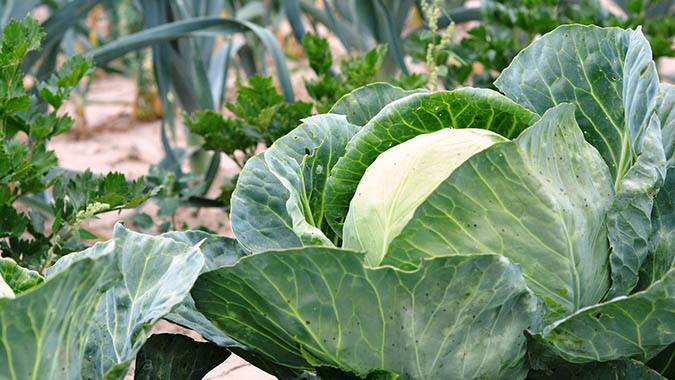If you’ve got a little time to wait, you can prepare a garden bed for planting using the absolute simplest method.
The Easiest Way to Prepare a Garden Bed
In this short video, you’ll see the easiest way to prepare a garden bed. Seriously, this is a way to take an area with grass and weeds, and turn it into a garden bed of your dreams. It takes a little time—a few months or more, depending on the intensity of your area’s sun and heat—so this method is definitely something you’ll want to plan ahead for.
This brief, easy-to-watch video takes you step-by-step through the preparation process—from the very beginning when you fence off an area to the very last step, which is laying down the compost. Preparing your garden beds has never been easier!
This is a sample of the kinds of things you’ll learn when you take The Grow Network’s “Instant Master Gardener” eCourse. Chock full of useful, doable information for taking your garden to the next level, “Instant Master Gardener” is available two ways:
- You can either buy it individually here; or
- You can access it (along with dozens of other eCourses) as a member of our TGN Academy. Click here to join the TGN Academy today—at a huge discount!
______________
This is an updated version of an article that was originally published on February 28, 2018.
Marjory Wildcraft is the founder of The Grow Network, which is a community of people focused on modern self-sufficient living. She has been featured by National Geographic as an expert in off-grid living, she hosted the Mother Earth News Online Homesteading Summit, and she is listed in Who’s Who in America for having inspired hundreds of thousands of backyard gardens. Marjory was the focus of an article that won Reuter’s Food Sustainability Media Award, and she recently authored The Grow System: The Essential Guide to Modern Self-Sufficient Living—From Growing Food to Making Medicine.









COMMENTS(8)
I bought a digging fork when I went through The Grow Network’s “Bio-Intentise Gardening” certification. Now I’m wondering, “how did I live without this?” That certification had a LOT of game-changing tips for me.
This is great information for preparing a new bed. But approximately how long does one leave the black plastic/ carpet before the next step?
This is exactly what I need to know, as I prepare for my first real garden bed this spring. I am a total beginner and learned of this website from a podcast with Sarah Westall. This is wonderful information. Thanks a ton!
Great information. Didn’t hear how long to keep down the covering though.
At the beginning of the video she mentions the covering was left down for the prior year. It kills the grass and weeds. If you can’t leave a cover down for a year, then you will have to dig up the existing grass and remove it.
The best way is to cut the grass patch into smaller size pieces. Think of cutting the grass patch into pieces as you are looking down at it. For the beds in the video, they were 4′ wide x 25′ long.
If you have a lawn, then the grass and its roots are quite dense. It will take more effort. The best way is for you to visualize what you need to do. Imagine your 4’x100′ bed as if it were a brick wall laid on the ground. You need to cut the grass into manageable size “bricks” to make it easy to lift them out of the ground.
First position a wheelbarrow or a big bucket nearby. You will toss the grass pieces into here. You have to remove the grass from the garden area. So a wheelbarrow works best to cart the stuff away
Now dig straight down into the grass and ground with a straight edged spade. Make a line cut into the ground, across the four foot width of the planned garden bed. Make another cut, parallel to the first, 8 inches or so apart. The cut straight down at 90 degrees into the ground between the two cut lines. You are making a “brick” shape, a rectangle. Then it is easier to lift up the grass with your pitchfork. Shake off the excess dirt and then toss the grass into a wheelbarrow. You can compost this grass so it is fresh made mulch for later in the year.
For grass that is not as dense as a lawn, it is easier. You may be able to avoid the additional work of the cutting lines approach above. You may be able to just use a pitchfork to dig up the grass in bunches !
Experiment to find what works best for you for your strength and endurance. There is no “right” way or “wrong” way !
I’ve been using unfolded brown cardboard boxes instead of plastic for years now. It’s usually pretty easy to get a lot of it for just asking local stores, kills weeds incredibly well, lasts all year, and the worms absolutely love it. By the time I peel it up they’ve eaten everything but the top layer. What they don’t eat I either just burn or compost. The only real downside I’ve found is that it’s a real pain to pull out all the metal staples and peel off the plastic packing tape before I lay it down.
I use cardboard for keeping paths weed free but I like the idea of solarizing a new bed to cut down on grubs and nematodes before I plant. I usually only solarize for 3 months in the summer here on the hot Gulf Coast and it does the job.
I fundamentally disagree with the title the easiest way to prepare a garden bed. I don’t necessarily think this is the wrong way, likely even the best way, but it is hardly the easiest.
The easiest and I have used this on multiple yards is to put the compost down, put plain non glossy brown boxes down to block the weeds even two layers if the weeds are bad then some kind of mulch down to keep the boxes from blowing away. Wood chips, straw, leaves, grass clippings all work. Anything that will compost down without leaving chemicals behind works as a mulch. I usually do this in the fall and you will need to cut through the boxes to plant in spring. Within a couple of years the boxes will be eaten by the earthworms who love them.
If weeds come up scrape back the mulch to prevent nitrogen loss, wood / high carbon mulches eat nitrogen to break down, and repeat the above procedure on top of the weeds. Compaction of even double dug beds is worse than under the boxes in a year or two so you tend to have to keep turning the soil every couple of years. Keep in mind you will still need nutrients added to the top, compost on top of the mulch works just fine. You will also need to add more mulch back once it composts. Like with all mulch make sure your source is organic or at least no persistent broad leaf weed killer is used. There are herbicides out there that go right through the animal and kills your soil for a few years.
I tend to use this method to start new garden areas then lasagna garden to get raised beds and improve the soil.